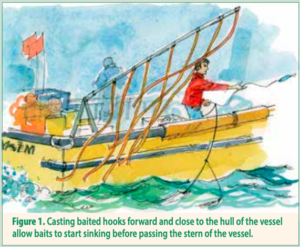Side Setting
WHAT IS SIDE-SETTING?
Side-setting is the process of deploying baited hooks from the side of the vessel, rather than the traditional process of deploying hooks to the stern of the vessel. This technique works to reduce seabird interactions with gear, as seabirds tend only to forage behind vessels, avoiding the sides. By the time hooks have reached the stern of the vessel due to drag, they will be below the reach of diving seabirds.
This technique also means baited hooks aren’t deployed into the propeller wash, which can slow the sink rate of baited hooks. By avoiding the propeller wash, sink rate is increased.
Various definitions of ‘side-setting’ exist, for example, fishery regulations in Hawaii define side-setting as 1 metre forward of the stern of the vessel. The Agreement of the Conservation of Albatrosses and Petrels (ACAP) recommends that hooks be cast well forward of the setting position by hand, but close to the hull of the vessel, to allow hooks time to sink as far as possible before they reach the stern.
ACAP stresses that side-setting should be using in conjunction with line-weighting and a brickle curtain, and that these three techniques be considered a single measure.

Source: ACAP
CURRENT RESEARCH & USE
Side-setting was developed in pelagic longline fisheries in the North Pacific near Hawaii, on small vessels, and has proven to be effective here. Certain vessels in Hawaii are now required by fishery regulations to side-set, as well as use line weighting and a bird curtain.
However, all experimental have been limited to this area of the North Pacific, and with surface-feeding seabirds. Side-setting is yet to be studied in the Southern Hemisphere, under more challenging sea conditions and with seabirds of differing diving abilities. A study in 2006 tested the applicability of side-setting as a mitigation technique to large Japanese longline vessels. Preliminary analysis of the results was promising, with side-setting proving to be practically feasible and improving the sink rate of baited hooks.
This page was last updated on 15.02.21.
Interested in how this and other measures could mitigate bycatch in your fishery? Get in touch with us to collaborate or take part in a study.
